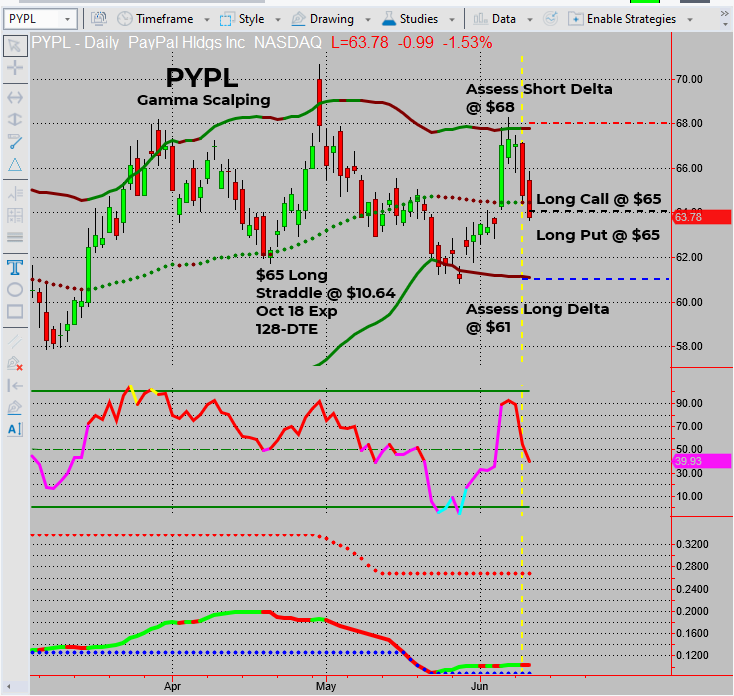Gamma scalping is a sophisticated trading strategy used primarily by options traders to manage their portfolio’s risk and profitability. It involves dynamically adjusting a portfolio to remain delta-neutral while benefiting from changes in the underlying asset’s volatility.
Here’s a breakdown of the key concepts involved in gamma scalping:
Key Concepts:
- Delta (Δ):
- Delta measures the sensitivity of an option’s price to a $1 change in the price of the underlying asset. For example, a delta of 0.5 means that if the underlying asset’s price increases by $1, the option’s price is expected to increase by $0.50.
- Gamma (Γ):
- Gamma measures the rate of change of delta with respect to changes in the underlying asset’s price. It indicates how much the delta will change if the underlying asset’s price changes by $1. High gamma means that delta is more sensitive to movements in the underlying asset.
- Delta-Neutral Position:
- A portfolio is delta-neutral when the sum of the deltas of all the options and the underlying asset in the portfolio is zero. This means that small movements in the underlying asset’s price will not significantly affect the portfolio’s value.
How Gamma Scalping Works:
- Initial Setup:
- The trader starts with a delta-neutral position, which might involve holding both options and the underlying asset in specific proportions so that the overall delta of the portfolio is zero.
- Managing the Position:
- As the price of the underlying asset changes, the delta of the options will change due to gamma. To maintain a delta-neutral position, the trader needs to adjust their holdings of the underlying asset.
- Frequent Adjustments:
- If the underlying asset’s price increases, the delta of call options (or the absolute value of delta for put options) will increase. To stay delta-neutral, the trader needs to sell some of the underlying asset.
- Conversely, if the underlying asset’s price decreases, the delta of call options (or the absolute value of delta for put options) will decrease, and the trader will need to buy more of the underlying asset.
- Profit from Volatility:
- The strategy benefits from high volatility. Frequent price swings of the underlying asset allow the trader to buy low and sell high or vice versa, taking advantage of the changes in delta. This is where the profit potential lies.
- Transaction Costs:
- Gamma scalping involves frequent trading of the underlying asset to maintain delta neutrality. Therefore, transaction costs can be significant and need to be carefully managed. The profitability of the strategy depends on the ability to generate enough profit from volatility to cover these costs.
Example Scenario:
- Initial Position:
- A trader holds an option portfolio with a net delta of zero. Suppose this portfolio includes a long position in options with positive gamma.
- Price Movement:
- If the price of the underlying stock increases, the portfolio’s delta becomes positive. To return to delta-neutral, the trader sells some shares of the underlying stock.
- If the stock price decreases, the portfolio’s delta becomes negative. The trader buys some shares to return to delta-neutral.
- Repeated Adjustments:
- These adjustments are repeated as the price of the underlying asset moves up and down. Each adjustment is an opportunity to capture small profits from the changes in the underlying asset’s price.
Conclusion:
Gamma scalping is a technique used to manage risk and potentially profit from the volatility of the underlying asset. It requires a deep understanding of options Greeks, active monitoring, and frequent trading adjustments to maintain a delta-neutral position. While it can be profitable in volatile markets, the strategy also involves risks and costs that must be carefully managed.
Gamma Scalping Strategies
Gamma Scalping:
Gamma scalping is a sophisticated trading strategy used primarily by options traders to manage their portfolio’s risk and profitability. It involves dynamically adjusting a portfolio to remain delta-neutral while benefiting from changes in the underlying asset’s volatility. This is a great strategy for trading sideways markets, often considered the bane of traders.
Deeper Dive:
In my Fast Forward Trading Mentorship, we explore diverse trading strategies to achieve diversification. Gamma Scalping is one of my favourite strategies, rarely discussed in retail trading circles but a staple in professional trading toolboxes. Here are the three ways I use the principles of gamma scalping:
- Hedging: Protect your portfolio against adverse market movements.
- Profit Locking: Secure gains by adjusting positions based on delta.
- Risk Mitigation: Reduce potential losses by flattening the delta.
Understanding Delta:
An option contract controls 100 shares of the underlying stock. The option’s value fluctuates with the stock’s price, a measure called Delta. At expiration, the delta will be 100 if the option is in the money (resulting in the assignment of shares) or zero if it’s out of the money (worthless).
Example with PayPal:
Recently, we set up a long straddle on PayPal, buying both a call and put at the $65 strike, expecting the stock to meander sideways. As the stock moved, the long put increased in value, showing a profit with a delta of approximately 75. By buying 75 shares of PayPal, we flattened the delta and locked in profits.
The goal is for the stock to move back to $65 or higher, allowing us to close the stock portion of the gamma scalp and transfer profits to the account. This process can be repeated multiple times over the next few weeks.

Different Approaches:
- Directional View: Place only a call or put to reduce the number of times needed to profit lock.
- Profit Locking: Secure profits by adjusting positions based on market movements.
- Hedging: Protect against uncertain economic events or expected retracements.
- Risk Mitigation: Lock in small losses and potentially turn them into breakeven or profitable positions.
Key Points:
- Gamma Scalping Techniques: Hedging, Profit Locking, Risk Mitigation.
- Example: PayPal long straddle strategy.
- Strategy Benefits: Ideal for directionally neutral trading in sideways markets.
